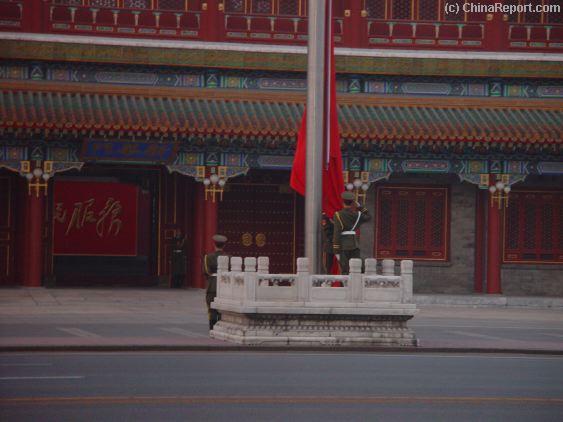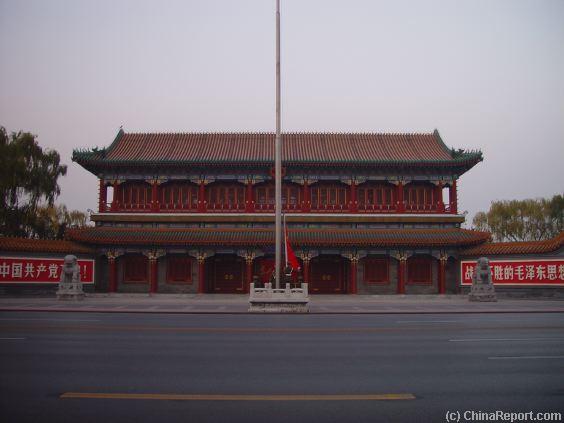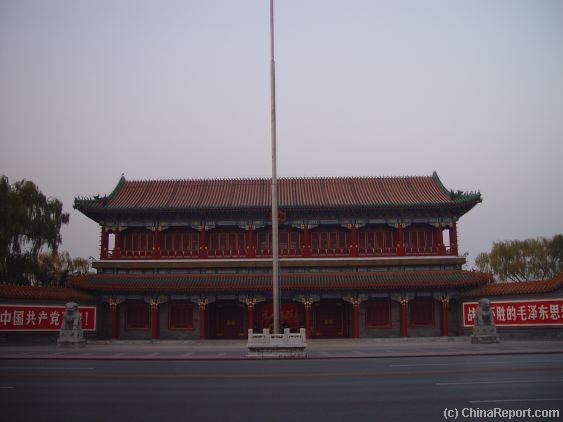In 1989 protesting students attempted to storm the gate, only to be repulsed by troops. Hunger strikers who subsequently gathered outside the walls were ignored, and the demonstration was eventually quashed. During the massacre, many protesters were killed by tanks careening in close proximity to the gate at the Liubukou intersection. More recently, in April of this year, a mass prayer rally organized around Zhongnanhai by practitioners of Falun Gong precipitated a harsh ban on the meditation group.
A Shematic Map of Beiping (Beijing) and immediate vicinity in the Year 1912 AD, using the Old (and oudated) naming sytem.
Map depicts major and minor roads, villages and Towns, Walled City of Beijing, Various Palaces of the Imperial Family, Temples, Mosques and Churches, The new railroad stations and lines such as Qianmen Station and Xizhimen Station both oustide the City Walls of Beijing, The Legations, buildings used by The Government of the First Republic of China, all city gates, outlying villages and roads, rivers in the region and more.
Map updated regularly !
In If any of these protesters had made it past the guards they would have confronted the imposing "screen wall" just inside Xinhuamen. It is inscribed with a slogan in Chairman Mao's calligraphy that reads "Serve the People." Those who know the code of this slogan read it as "Keep out, restricted access."
Beyond the wall is a vast expanse of water, known as the South Sea. Skirting the lake toward the north is an ornamental island, Yingtai, or Ocean Terrace, where the ill-fated Guangxu emperor was imprisoned by the Empress Dowager Cixi after his failed attempt in 1898 to carry out economic and political reform. Today it's a scenic spot for the occasional exhibition and the delectation of select tourists. Apart from Yingtai, the lakes and a few scant pavilions, little of the imperial era survives. Energetic bureaucrats under the Republic and the People's Republic have razed most of the dynastic-era buildings.
What has survived exists in bizarre symmetry with the past. The inappositely named Palace Steeped in Compassion (Huairentang) has been rebuilt for party and government meetings. Many of the most momentous--and occasionally infamous--decisions of the party leadership have been made here. This is where Deng Xiaoping met with the commanders of the troops that crushed the 1989 protest movement. Further north is the Throne Hall of the Effulgent Pole-star (Ziguangge), which once was used to receive barbarian tributaries. For the past half-century, it has been a reception hall for visiting foreign dignitaries.
The extravagant late-Qing halls have been refitted with an eye to Chinese peasant aesthetics. State-of-the-art surveillance equipment monitors rooms filled with ungainly Eastern Bloc furniture, el cheapo light fixtures and chunky neo-traditional objets d'art. Outside, the geometry of the original landscaping has been undone by macadamized roads and cement parking lots for the official limousines that ferry comrades from plenum to post.
Getting into Zhongnanhai has always been hard work, and once you're in, staying there has never been easy. Thinkers, economists and rebels have all vied to be received there by party leaders. To "be called to Zhongnanhai" is an expression with powerful resonance among advisers on the make even today. Some who have made it into Zhongnanhai never got out alive. The most famous suicide was Mao's personal secretary, Tian Jiaying, who killed himself in the early phase of the Cultural Revolution.
The current party chief, Jiang Zemin, calls Zhongnanhai home. For Premier Zhu Rongji, though, it's just an office. Upon his ascension to Beijing, Zhu opted to keep the place at arm's length, taking up residence in a guarded compound nearby. If he topples from grace, at least he won't have that far to go.



